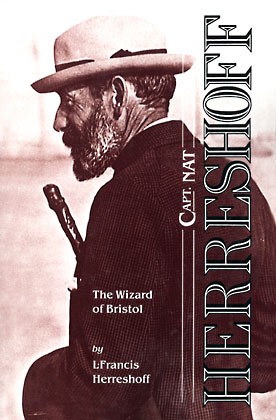 |
Nathaniel Greene Herreshoff would be on any yacht
design historian's short list of candidates for greatest designer
who ever lived. Indeed there are those for whom their devotion
to him approaches being religious in nature. At the very least
we should expect to learn a great deal that is valuable in the field
of yacht design from a good biography of so skilled a designer.
Not only were a great many of his boats examples of discoveries of
underlying aesthetic principles of design unrecognized before his
time, but also he was one of the first people to apply science and
structural analysis to yacht designing. On top of that he not
only had a better understanding of how to do lines with excellent
waterflow characteristics than virtually anyone else of his time,
but even today there are very few designers with the same level of
understanding of hydrodynamics that Nathaniel Herreshoff exhibited.
A walk through almost any boat yard today shows that there are far
too many boats being designed by those who have not put in anything
like the study and understanding that Herreshoff did. Fortunately his biographer is not only his son L. Francis who is a very gifted writer who was at his father's side a great deal of the time, but L. Francis was also a truly great yacht designer himself. While he designed differently than his father a great deal of the time, L. Francis was also extremely skilled at structures and aesthetics. He was so innovative that he was virtually forced out of designing racing boats as the racing authorities got in the habit of banning a number of his boats as too radical. Today virtually everyone of these innovations is widely used. All this means that this biography is extremely authoritative and if you pay attention to the descriptions of how Herreshoff thought and designed you can learn a lot that is quite vital about good design. In our yacht design school we teach a lot of the methods invented by Herreshoff. Very few people realize how advanced his knowledge was. We are very fortunate this biography exists because Herreshoff himself had little use for people who simply wanted him to tell them his "secrets" so they could design like he did. He tended to respond that they should go out and put in the hard work and figure this stuff out for themselves. While I teach as close as possible to everything I know to my students, I have come to realize that Herreshoff's response is not as ungracious as it might seem. We have found that the students of design who are most eager to just soak up everything we can teach them, will probably be great designers because they are going to continue to work hard at understanding everything and will hopefully go on to surpass our knowledge. On the other hand some people want quick answers and are quite sure that they can speed learn this stuff. We've found that they just plain aren't really likely to keep at it long enough to be really good. I have a strong feeling that when a really good student came along who was really dedicated to doing the best work possible that Herreshoff probably worked pretty hard at helping them as much as possible. In any case if we really want to learn from Capt. Nat these days so long after his death, this book, the Herreshoff Museum, in Bristol, and the continuing generations of yacht designers in this family are our only sources of information. For most of us this book is the easiest source to consult. Everyone with a serious interest in good yacht design should read this book. (349 pages) (tm) $29.95 |